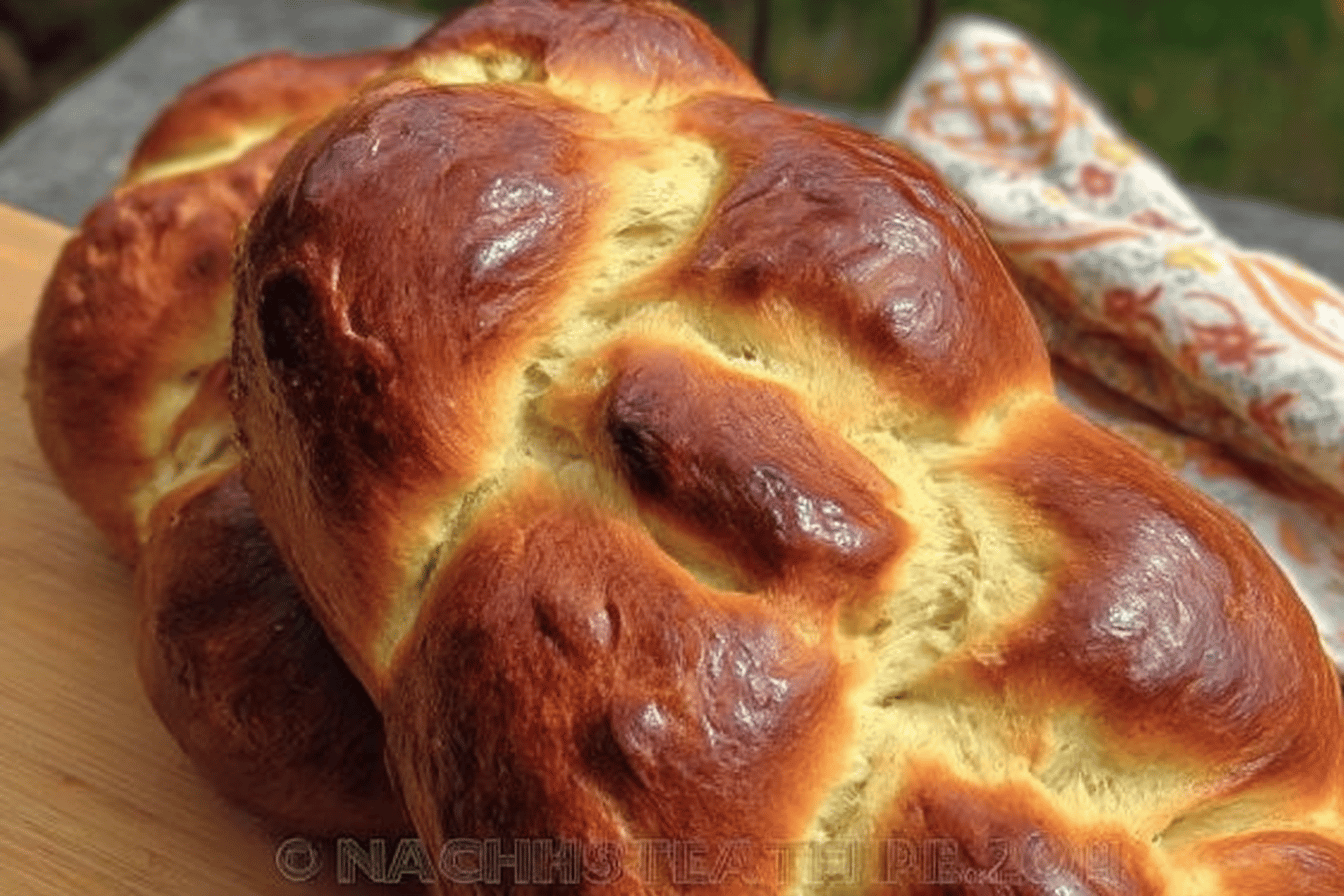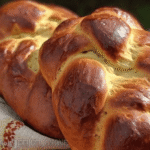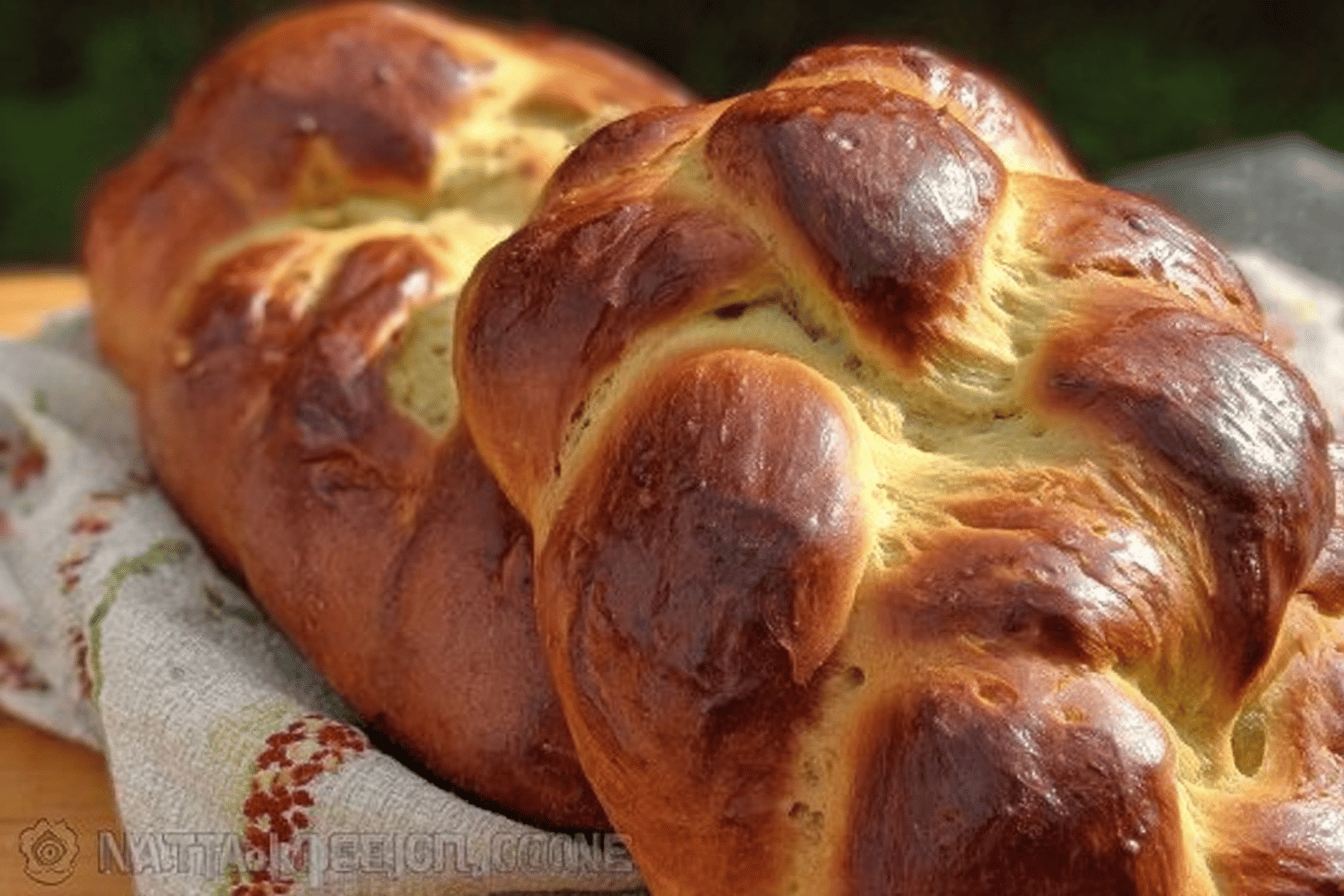Why You’ll Love This Portuguese Easter Bread
Imagine pulling a warm, fluffy loaf of Portuguese Easter Bread from your oven, filling your kitchen with the inviting scent of citrus and anise. This traditional treat, known as Folar de Pascoa, combines simple ingredients like all-purpose flour, yeast, milk, citrus zest, and anise seed to create a sweet, brioche-style bread that’s perfect for holiday celebrations. It’s not just delicious it’s adaptable for everyone from busy parents to baking enthusiasts, making it a go-to recipe for family gatherings or quiet mornings.
One reason you’ll adore this bread is its ease of preparation. With straightforward steps that fit into your daily routine, you can mix, knead, and bake without needing fancy tools, ideal for home cooks just starting out. Plus, the health benefits shine through, as it includes wholesome elements like fiber from the flour and natural nutrients from eggs and milk, offering a balance of carbs, protein, and vitamins that keep you energized.
Beyond that, the versatility stands out tweak it for dietary needs, such as swapping in gluten-free flour or vegan alternatives, without losing that signature soft texture. What really sets Portuguese Easter Bread apart is its distinctive flavor, blending subtle sweetness with zesty lemon and orange peels plus a hint of anise seed, evoking traditions of new life and fertility represented by two naturally dyed red boiled eggs baked right into the loaf.
Health and Nutritional Highlights
Diving deeper, each serving packs about 201 calories, with 31g of carbohydrates for sustained energy, 8g of protein to support your day, 5g of fat for richness, and 2g of fiber for digestion. You’ll also get a boost of key nutrients like vitamin A, vitamin C, calcium, and iron, making this bread a smart choice for diet-conscious folks. Whether you’re a student grabbing a quick bite or a senior enjoying a nostalgic treat, this recipe brings joy and nutrition to the table.
Jump To
- 1. Why You’ll Love This Portuguese Easter Bread
- 2. Essential Ingredients for Portuguese Easter Bread
- 3. How to Prepare the Perfect Portuguese Easter Bread: Step-by-Step Guide
- 4. Dietary Substitutions to Customize Your Portuguese Easter Bread
- 5. Mastering Portuguese Easter Bread: Advanced Tips and Variations
- 6. How to Store Portuguese Easter Bread: Best Practices
- 7. FAQs: Frequently Asked Questions About Portuguese Easter Bread
- 8. Portuguese Easter Bread
Essential Ingredients for Portuguese Easter Bread
Gathering the right ingredients is the first step to baking a perfect Folar de Pascoa. This sweet bread relies on quality items to achieve its fluffy, brioche-like texture, featuring citrus zest and anise seed for that authentic Portuguese flavor. Below, you’ll find a complete list, divided into sections for the sponge and the dough, to make shopping and measuring straightforward.
Ingredients for the Sponge
- ½ cup all-purpose flour
- 1 tablespoon granulated sugar
- 2 ¼ teaspoons instant yeast
- ½ cup water
Ingredients for the Dough
- 3 cups unbleached all-purpose flour
- 6 tablespoons water
- 2 large eggs
- 7 tablespoons sugar
- ½ cup full-fat milk
- ½ teaspoon salt
- 2 tablespoons butter, room temperature
- 2 tablespoons vegetable shortening
- Zest of 1 lemon
- Zest of 1 orange
- ½ teaspoon anise seed
- 1 egg (for egg wash)
- 2 naturally dyed boiled eggs (traditionally red)
This structured list ensures you have every item needed, with precise measurements to avoid any guesswork. For special options like vegan or gluten-free versions, you can adapt as noted in other sections, keeping the essence of this festive bread intact.
How to Prepare the Perfect Portuguese Easter Bread: Step-by-Step Guide
Creating Folar de Pascoa at home starts with a simple sponge that builds a strong base for the dough, leading to a light and airy bread. This process, rooted in Portuguese traditions, involves mixing and fermenting ingredients to capture that symbolic Easter spirit with two naturally dyed red boiled eggs. Follow these steps to bring a touch of cultural heritage to your kitchen.
Starting with the Sponge
First, mix the sponge by combining ½ cup all-purpose flour, 1 tablespoon granulated sugar, 2 ¼ teaspoons instant yeast, and ½ cup water in a bowl. Let it ferment for about an hour until it’s foamy and active, which helps the bread rise beautifully. For more sweet bread ideas, check out our Sweet Alabama Pecan Bread recipe for inspiration on variations.
Creaming and Mixing the Dough
Next, cream together 2 tablespoons butter and 2 tablespoons vegetable shortening in a separate bowl, then add 7 tablespoons sugar, ½ teaspoon salt, and ½ teaspoon anise seed. Stir in 2 large eggs and the zests of 1 lemon and 1 orange for that fresh burst of flavor. Incorporate the foamy sponge and 3 cups unbleached all-purpose flour, along with 6 tablespoons water as needed, to form a soft dough.
Kneading and Rising
Knead the dough for 10-12 minutes using a mixer or about 15 minutes by hand until it reaches 77°F to 88°F, making it smooth and elastic. Place it in an oiled bowl, cover, and let it rest for 2 hours until doubled in size. For plant-based swaps, you can use almond milk here to keep things versatile.
Shaping and Baking
Divide the dough into one large boule (about 670g) and four smaller pieces (totaling about 277g). Shape the large piece into a round loaf and the smaller ones into long ropes. After a 1-2 hour proofing period until puffy, preheat your oven to 350°F. Brush the loaf with egg wash, arrange the two naturally dyed boiled eggs on top, and place the twisted ropes over them to form a cross. Brush again with egg wash and bake for 30-40 minutes until golden brown and at 185°F internally. If it browns too fast, cover with foil. Let it cool for at least 90 minutes before slicing to soften the texture.
| Step | Time Estimate | Tips |
|---|---|---|
| Making the Sponge | 1 hour | Keep in a warm spot for even fermentation |
| Kneading and First Rise | 2-2.5 hours | Aim for smooth dough to ensure good rise |
| Shaping and Proofing | 1-2 hours | Add eggs after proofing to prevent sinking |
| Baking | 30-40 minutes | Use a thermometer for perfect doneness |
Dietary Substitutions to Customize Your Portuguese Easter Bread
Making Folar de Pascoa your own is easy with a few swaps, ensuring it’s enjoyable for everyone from food enthusiasts to those with restrictions. Start by replacing eggs with flaxseed or chia seed alternatives for vegan options, which keep the dough binding nicely while adding a nutty twist.
- Use plant-based butter or oils like coconut oil instead of dairy butter to maintain that rich flavor.
- Switch to gluten-free flour blends for sensitive diets, ensuring the bread stays light and airy.
- Reduce sugar or use natural sweeteners for a lower-calorie version, perfect for working professionals watching their intake.
- Experiment with spices like nutmeg alongside anise seed to create new flavors that suit busy parents’ tastes.
This flexibility lets you honor the tradition of Portuguese Easter Bread while making it fit your lifestyle, symbolizing renewal in every bite.
Mastering Portuguese Easter Bread: Advanced Tips and Variations
Once you’re comfortable with the basics, elevate your baking with pro techniques that make Folar de Pascoa even better. Use a stand mixer for even kneading, and don’t skip multiple proofing stages to develop a deeper, more complex flavor in this brioche-style bread.
Flavor and Presentation Ideas
Try adding orange or lime zest for a fresh variation, or mix in cinnamon and nuts for extra texture it’s a hit with travelers exploring new tastes. For presentation, braid the dough before baking to give it that classic festive look, and finish with a light glaze of lemon juice and sugar.
Make-Ahead Strategies
Prepare the dough ahead and refrigerate it overnight for richer flavors, ideal for newlyweds or seniors planning ahead. You can also partially bake and freeze the bread, making it simple to reheat on busy days. Remember, tips like using full-fat milk enhance softness, and adding dyed eggs after the second proof keeps them from sinking.
How to Store Portuguese Easter Bread: Best Practices
Keeping your Folar de Pascoa fresh means storing it properly to preserve its soft, flavorful crumb. Wrap the cooled bread tightly in plastic or place it in an airtight container at room temperature for 2-3 days, which works well for everyday meals.
- Freeze it by wrapping in foil and a freezer bag for up to 3 months, then thaw at room temperature.
- Reheat slices in a 300°F oven for 5-10 minutes to bring back that just-baked warmth.
- For meal prep, slice and store portions separately so you can enjoy it anytime without waste.
These methods help maintain the bread’s nutritional profile, including its vitamins and minerals, making it a reliable treat for all.

FAQs: Frequently Asked Questions About Portuguese Easter Bread
What is Portuguese Easter Bread (Folar de Páscoa)?
Portuguese Easter Bread, known as Folar de Páscoa, is a traditional sweet bread commonly prepared during Easter in Portugal. It often contains boiled eggs either baked into or placed on top of the dough, symbolizing fertility and renewal. The bread usually features a cross mark on top, representing the crucifixion of Christ. Variations exist by region, including savory versions like Folar de Chaves with smoked meats and sweet versions flavored with cinnamon, sugar, and anise seeds.
How do I make authentic Folar de Páscoa at home?
To make authentic Folar de Páscoa, you’ll need ingredients such as all-purpose flour, sugar, eggs, SAF gold yeast (or more yeast if unavailable), salt, citrus zest (lemon and orange), anise seeds, full-fat milk, water, and butter. Begin by preparing a sponge with yeast and water to activate fermentation. The dough is enriched with butter and eggs, creating a brioche-like texture. Once mixed and risen, shape the dough, add red-dyed boiled eggs on top, and bake until golden brown.
What’s the best way to shape and decorate Folar de Páscoa bread?
Folar de Páscoa is typically shaped into a round or oval loaf. Boiled eggs, traditionally dyed red, are nestled into the dough, secured with strips or crosses of dough on top. The cross is an essential decoration symbolizing Christ’s crucifixion. Some bakers score a cross directly on the dough instead of adding shaped dough. This finishing step happens before baking and helps give the bread its signature Easter look.
How should I store Portuguese Easter Bread to keep it fresh?
After baking, cool the bread completely on a wire rack. Store the Folar de Páscoa at room temperature, well-wrapped in plastic wrap or an airtight container, for up to several days. For longer storage, you can freeze the bread wrapped tightly in foil and plastic; thaw at room temperature when ready to eat. To refresh the bread, lightly toast slices or warm them with butter.
Why are eggs baked into Portuguese Easter Bread?
The eggs in Portuguese Easter Bread symbolize rebirth, fertility, and new life, aligning with Easter’s themes of resurrection. Historically, eggs represented the arrival of spring and renewal in various cultures. The tradition of baking eggs into the bread reinforced this symbolism within Christian communities, marking the resurrection of Jesus and the hope for new beginnings during Easter celebrations.

Portuguese Easter Bread
- Total Time: 4 hours 15 minutes
- Yield: 1 large loaf
- Diet: Vegetarian
Description
🍞 Folar de Pascoa is a traditional Portuguese sweet Easter bread symbolizing new life with its iconic red eggs and rich, aromatic dough.
🌿 This brioche-style bread combines citrus zest and anise seed for a fragrant, soft, and festive treat perfect for holiday celebrations.
Ingredients
– ½ cup all-purpose flour
– 1 tablespoon granulated sugar
– 2 ¼ teaspoons instant yeast
– ½ cup water
– 3 cups unbleached all-purpose flour
– 6 tablespoons water
– 2 large eggs
– 7 tablespoons sugar
– ½ cup full-fat milk
– ½ teaspoon salt
– 2 tablespoons butter, room temperature
– 2 tablespoons vegetable shortening
– Zest of 1 lemon
– Zest of 1 orange
– ½ teaspoon anise seed
– 1 egg for egg wash
– 2 naturally dyed boiled eggs traditionally red
Instructions
1-Starting with the Sponge: First, mix the sponge by combining ½ cup all-purpose flour, 1 tablespoon granulated sugar, 2 ¼ teaspoons instant yeast, and ½ cup water in a bowl. Let it ferment for about an hour until it’s foamy and active, which helps the bread rise beautifully. For more sweet bread ideas, check out our Sweet Alabama Pecan Bread recipe for inspiration on variations.
2-Creaming and Mixing the Dough: Next, cream together 2 tablespoons butter and 2 tablespoons vegetable shortening in a separate bowl, then add 7 tablespoons sugar, ½ teaspoon salt, and ½ teaspoon anise seed. Stir in 2 large eggs and the zests of 1 lemon and 1 orange for that fresh burst of flavor. Incorporate the foamy sponge and 3 cups unbleached all-purpose flour, along with 6 tablespoons water as needed, to form a soft dough.
3-Kneading and Rising: Knead the dough for 10-12 minutes using a mixer or about 15 minutes by hand until it reaches 77°F to 88°F, making it smooth and elastic. Place it in an oiled bowl, cover, and let it rest for 2 hours until doubled in size. For plant-based swaps, you can use almond milk here to keep things versatile.
4-Shaping and Baking: Divide the dough into one large boule (about 670g) and four smaller pieces (totaling about 277g). Shape the large piece into a round loaf and the smaller ones into long ropes. After a 1-2 hour proofing period until puffy, preheat your oven to 350°F. Brush the loaf with egg wash, arrange the two naturally dyed boiled eggs on top, and place the twisted ropes over them to form a cross. Brush again with egg wash and bake for 30-40 minutes until golden brown and at 185°F internally. If it browns too fast, cover with foil. Let it cool for at least 90 minutes before slicing to soften the texture.
Notes
🥚 Add dyed eggs only after second proof to prevent sinking.
🥛 Use full-fat milk for richer flavor and softer texture.
🛍️ Store wrapped at room temperature for 2-3 days or freeze for longer storage.
- Prep Time: 15 minutes
- Rising and proofing time: 3 to 4 hours
- Cook Time: 40 minutes
- Category: Bread
- Method: Baking
- Cuisine: Portuguese
Nutrition
- Serving Size: 1 slice
- Calories: 201 kcal
- Fat: 5 g
- Carbohydrates: 31 g
- Fiber: 2 g
- Protein: 8 g
Keywords: Folar de Pascoa,Easter bread,Portuguese sweet bread,Traditional holiday bread


